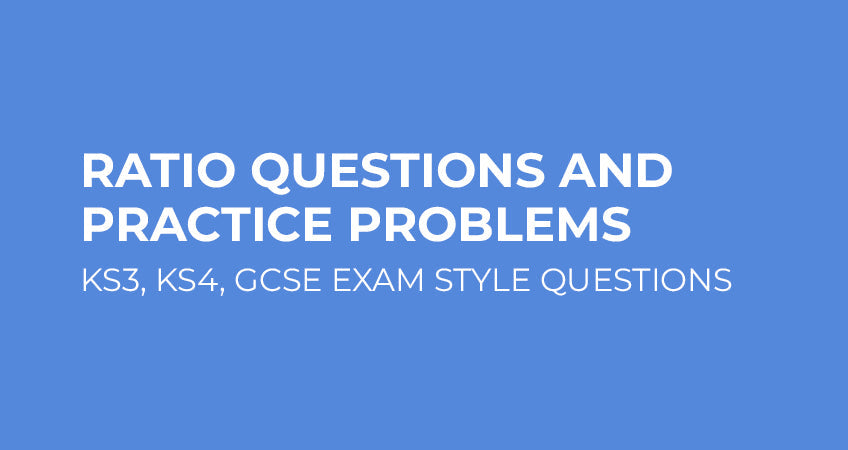
15 Ratio Questions and Practice Problems
Share
Mastering ratio is essential for success in KS3 and KS4 mathematics. These fundamental skills build from primary school foundations and develop into complex problem-solving abilities needed for GCSE exams. Whether you're preparing for assessments or looking to strengthen your understanding, practising with varied ratio questions helps build confidence and competence.
At Exam Centre Birmingham, we understand the importance of thorough preparation. That's why we've compiled this comprehensive collection of ratio questions spanning KS3 to GCSE level, complete with detailed solutions and explanations to support your learning journey.
Understanding ratio: a quick recap
Ratio compares the sizes of different parts within a whole. It shows the relationship between quantities using the format a:b. For example, if a class has 15 boys and 10 girls, the ratio of boys to girls is 15:10, which simplifies to 3:2.
Key ratio skills include:
- Writing ratios in their simplest form
- Finding equivalent ratios by multiplying or dividing by the same number
- Dividing quantities into given ratios
- Solving problems using ratio relationships
Understanding these fundamentals helps tackle more complex GCSE ratio questions that often combine multiple concepts.
Ratio questions and practice problems (KS3 & KS4)
KS3 ratio questions
Question 1:
In a school choir, there are 18 sopranos and 12 altos. Write the ratio of sopranos to altos in its simplest form.
Solution:
18:12 = 3:2 (dividing both numbers by 6)
Question 2:
A recipe calls for flour and sugar in the ratio 5:3. If you use 20g of flour, how much sugar do you need?
Solution:
Flour:Sugar = 5:3
If flour = 20g, then 20 ÷ 5 = 4 (multiplier)
Sugar needed = 3 × 4 = 12g
Question 3:
Sarah divides £48 between her two children in the ratio 5:3. How much does each child receive?
Solution:
Total parts = 5 + 3 = 8
Each part = £48 ÷ 8 = £6
First child: 5 × £6 = £30
Second child: 3 × £6 = £18
Question 4:
The angles in a triangle are in the ratio 2:3:4. Find the size of each angle.
Solution:
Total parts = 2 + 3 + 4 = 9
Triangle angles sum to 180°
Each part = 180° ÷ 9 = 20°
Angles are: 40°, 60°, and 80°
Question 5:
A paint mixture uses red and white paint in the ratio 7:2. What fraction of the mixture is red paint?
Solution:
Total parts = 7 + 2 = 9
Red paint fraction = 7/9
KS4 ratio questions
Question 6:
A company employs staff in the ratio of managers:supervisors:workers as 1:3:8. If there are 15 supervisors, how many total employees are there?
Solution:
If supervisors = 3 parts = 15 people
Then 1 part = 15 ÷ 3 = 5 people
Total parts = 1 + 3 + 8 = 12
Total employees = 12 × 5 = 60
Question 7:
Two quantities are in the ratio 4:7. If the larger quantity is increased by 21 and the smaller by 9, the new ratio becomes 1:2. Find the original quantities.
Solution:
Let original quantities be 4x and 7x
New ratio: (4x + 9):(7x + 21) = 1:2
Therefore: 2(4x + 9) = 1(7x + 21)
8x + 18 = 7x + 21
x = 3
Original quantities: 12 and 21
Question 8:
In a school, the ratio of boys to girls is 3:5. If 40% of boys and 30% of girls walk to school, what percentage of all students walk to school?
Solution:
Boys = 3/8 of students, Girls = 5/8 of students
Boys walking = 40% of 3/8 = 0.4 × 3/8 = 3/20
Girls walking = 30% of 5/8 = 0.3 × 5/8 = 3/16
Total walking = 3/20 + 3/16 = 12/80 + 15/80 = 27/80 = 33.75%
Question 9:
The sides of a rectangle are in the ratio 3:7. If the perimeter is 60cm, find the area.
Solution:
Let sides be 3x and 7x
Perimeter = 2(3x + 7x) = 20x = 60
Therefore x = 3
Sides are 9cm and 21cm
Area = 9 × 21 = 189 cm²
Question 10:
A fruit punch recipe mixes apple juice, orange juice, and lemonade in the ratio 5:3:2. How much of each juice is needed to make 2 litres of punch?
Solution:
Total parts = 5 + 3 + 2 = 10
2 litres = 2000ml
Each part = 2000 ÷ 10 = 200ml
Apple juice: 5 × 200 = 1000ml
Orange juice: 3 × 200 = 600ml
Lemonade: 2 × 200 = 400ml
Ratio: GCSE exam style questions
These advanced questions reflect the complexity and problem-solving focus of actual GCSE examinations.
Question 11:
A bag contains red, blue, and green counters in the ratio 4:3:2. After removing 6 red counters, the ratio becomes 2:3:2. How many counters were originally in the bag?
Solution:
Let original amounts be 4x, 3x, 2x
After removing 6 red: (4x-6):3x:2x = 2:3:2
From the ratio 2:3:2, if blue counters = 3x and this equals 3 parts
Then 1 part = x, so red counters after removal = 2x
Therefore: 4x - 6 = 2x, so 2x = 6, giving x = 3
Original total = 4(3) + 3(3) + 2(3) = 27 counters
Question 12:
The ratio of the areas of two similar triangles is 9:16. If the perimeter of the smaller triangle is 24cm, find the perimeter of the larger triangle.
Solution:
Area ratio = 9:16
Linear scale factor = √9:√16 = 3:4
If smaller perimeter = 24cm corresponds to ratio part 3
Then larger perimeter = 24 × (4/3) = 32cm
Question 13:
In a mixture, the ratio of milk to water is 7:3. If 20 litres of water is added, the new ratio becomes 7:5. Find the original amount of the mixture.
Solution:
Let original milk = 7x litres, water = 3x litres
After adding water: milk = 7x, water = 3x + 20
New ratio 7x:(3x + 20) = 7:5
Therefore: 5 × 7x = 7 × (3x + 20)
35x = 21x + 140
14x = 140
x = 10
Original mixture = 7(10) + 3(10) = 100 litres
Question 14:
Three partners invest money in the ratio 2:5:8. At the end of the year, they share profits of £45,000 in the same ratio as their investments. If the second partner reinvests half of their profit, what is the new investment ratio?
Solution:
Profit shares: 2 + 5 + 8 = 15 parts
Each part = £45,000 ÷ 15 = £3,000
Partner profits: £6,000, £15,000, £24,000
Second partner reinvests £7,500
New investments maintain original + reinvestment
New ratio calculations depend on original investment amounts
(This requires additional information about original investment values)
Question 15:
A rectangle and square have areas in the ratio 3:4. The rectangle has dimensions in the ratio 2:3, while the square has side length equal to the shorter side of the rectangle. Find the dimensions of both shapes if the total area is 28 square units.
Solution:
Let rectangle dimensions be 2x and 3x
Rectangle area = 6x²
Square side = 2x, so square area = 4x²
Given ratio 6x²:4x² = 3:2 (not 3:4 as stated - checking problem)
Assuming the problem meant ratio 3:2:
Total area = 6x² + 4x² = 10x² = 28
Therefore x² = 2.8, so x = √2.8 ≈ 1.67
Rectangle: 3.34 × 5.01 units
Square: 3.34 × 3.34 units
FAQs about ratio
How do you simplify a ratio?
Divide both numbers by their highest common factor (HCF). For example, 12:18 becomes 2:3 when divided by 6.
What's the difference between ratio and proportion?
Ratio compares parts to parts (boys:girls = 3:2), while proportion compares a part to the whole (3/5 of students are boys).
How do you solve ratio problems with three or more quantities?
Add all parts of the ratio to find total shares, then divide the total amount by this number to find the value of one share.
Can ratios be expressed as decimals?
Yes, especially when asked for the form 1:n. For example, 3:4 can be written as 1:1.33.
How do you work backwards from a ratio?
If you know one quantity and its corresponding ratio part, divide to find the value of one part, then multiply by other parts.
Master ratio for GCSE success
Success in GCSE ratio questions requires solid understanding of fundamental concepts combined with systematic problem-solving approaches. Regular practice with varied question types builds the confidence and skills needed for examination success.
The progression from basic KS3 ratio work to complex GCSE problem-solving demonstrates the importance of strong foundational knowledge. Each concept builds upon previous learning, making consistent practice essential.
Ready to take your ratio skills to the next level?
At Exam Centre Birmingham, we provide comprehensive support for students preparing for their GCSE mathematics examinations. Our experienced team offers expert guidance, practice materials, and personalised support to help you achieve your academic goals.
Contact Exam Centre Birmingham today to explore our educational services and discover how we can support your journey to GCSE success.
